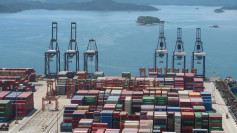As oil prices surge for the third consecutive week, the Federal Reserve, aiming for a soft landing for the U.S. economy, is once again haunted by the specter of inflation.
Since June of this year, driven by production cuts from OPEC+ heavyweights Saudi Arabia and Russia, global oil prices have soared by over 30%. This surge threatens to reignite inflation in the U.S., which the Fed has been striving to cool down.
This week, WTI crude oil prices surpassed $91 per barrel, while Brent crude exceeded $95 per barrel. Both have been on a three-week upward trend, nearing their highest points in the past ten months and are on track to record their largest quarterly increase since the Russia-Ukraine conflict in early 2022.
Although current oil prices remain below their 2022 peaks, the escalating energy costs could hinder the Fed's goal of reducing inflation to 2% without triggering a recession.
Driven by rising oil prices, there are clear signs of a significant rebound in U.S. inflation. In August, the U.S. Consumer Price Index (CPI) rebounded to 3.7% year-over-year. Energy costs were the primary contributor to the month-over-month increase in the U.S. CPI, accounting for more than half of the rise.
The U.S. Producer Price Index (PPI) for August also continued to rebound due to rising oil prices, growing by 1.6% year-over-year, surpassing the expected 1.3% and marking the second consecutive month of exceeding expectations. Month-over-month, it rose by 0.7%, the largest increase since June 2022.
In the 1970s, 80s, and early 90s, soaring energy costs were one of the reasons the U.S. fell into a recession, as they drove up inflation and eroded consumer purchasing power. Thus, energy costs can be considered the Fed's "arch-nemesis."
Traditionally, the Fed tends to downplay the impact of rising oil prices on inflation, viewing such phenomena as temporary. Hence, when examining economic data, the Fed prefers core inflation figures, which exclude energy and food costs.
Excluding energy and food, the U.S. core CPI for August increased year-over-year from 4.7% to 4.3%, meeting expectations and marking the smallest increase in nearly two years. However, the month-over-month core CPI accelerated for the first time in six months, rising slightly from 0.2% to 0.3%, surpassing the expected 0.2%.
This indicates that the pressure from rising oil prices is now spreading to other sectors. The Fed may now have to consider whether to raise benchmark interest rates again this year and extend the period of higher interest rates.
Currently, the market widely anticipates that the Fed will maintain interest rates during its meeting this week. However, the impact of rising oil prices and the automotive industry's major strike could put the Fed in a difficult position.
Lindsey Piegza, Chief Economist at Stifel Financial Corp., mentioned that energy costs are a significant uncertainty facing the Fed. This could lead to a significant reversal in overall inflation, forcing the Fed to take more aggressive actions than investors might anticipate.
Is the Biden Administration Out of Options? With the recent rise in oil prices, the Biden administration may not be able to intervene in oil prices by releasing reserves as it did before and is even considering replenishing reserves.
Data from the U.S. Energy Information Administration shows that the current U.S. Strategic Petroleum Reserve (SPR) crude oil inventory is approximately 351 million barrels, still at its lowest level since 1983.
Last March, President Biden announced the largest-ever release from the U.S. SPR of 180 million barrels of oil reserves to counteract the surge in oil prices, which exceeded $100 per barrel during the Russia-Ukraine conflict. The emergency release of the U.S. strategic oil reserve was priced at about $96 per barrel.
After this massive release, the U.S. strategic oil reserve levels dropped to their lowest since 1983.
In October of last year, the White House stated that it plans to repurchase oil for the SPR when WTI prices reach or fall below $67-72 per barrel. The U.S. State Department further clarified in November that the Department of Energy would begin repurchasing oil when prices stabilize around $70 per barrel. The White House expressed hopes that this would set a price floor to encourage future oil production.
However, in March of this year, when oil prices did fall into the aforementioned range, the U.S. government did not take action to replenish.
In early April, OPEC+, led by Saudi Arabia, unexpectedly announced a collective "voluntary" production cut. Some analysts suggest that OPEC+'s unexpected production cut was a veiled expression of dissatisfaction with the U.S. The White House had assured Saudi Arabia that if oil prices fell, it would intervene to replenish its strategic reserve. According to media sources familiar with Saudi thinking, the Biden administration's inconsistency angered Saudi Arabia.
However, even after learning from the unexpected OPEC+ production cut in April, the U.S. has been wavering on replenishing the SPR:
In mid-April, U.S. Energy Secretary Jennifer Granholm stated that the Biden administration plans to replenish the SPR as soon as possible, hoping to do so at lower prices favorable to taxpayers for the rest of the year.
Earlier in May, the U.S. government announced another delay in the SPR replenishment plan. The Department of Energy said it would maintain two of the four SPR storage sites and then replenish later this year.
Data from the U.S. Energy Information Administration shows a slight increase in the SPR in late August, but the change was minimal, possibly due to the high oil prices making it challenging for the U.S. government to act.






